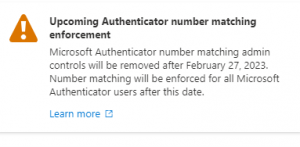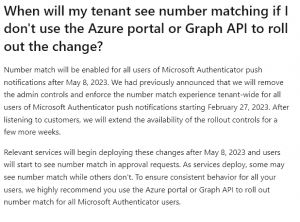Microsoft lack of spine networking
So, I’ve been talking to my security guy about Microsoft’s latest security backpedal. Let me tell you, he’s an unhappy bunny. Microsoft set a deadline of February 27th for enforcing Microsoft Authenticator number matching. Then they “listened to customers” and pushed it back to May 8th. Not only that, what they were previously going to enforce is now just going to be a default option that customers can switch off.


This flip-flop behaviour is a trend for Microsoft’s security announcements and it’s becoming laughably predictable.
They did the same with office macros and with switching off basic authentication.
What is number matching?
For those of you who don’t know, number matching is a security feature that requires users to enter a number on their device that matches the number in the authentication prompt. This added step helps prevent attackers from using stolen credentials to access the user’s account. And it’s important because push fatigue is a real thing. When users are bombarded with authentication requests, they start ignoring them or approving them through inattention or error. This makes it easier for attackers to access the user’s account. Number matching helps prevent push fatigue by adding an extra layer of security.
But Microsoft’s kicking the can down the road is just causing confusion and undermining trust. My security guy has been handholding users as he moves their Microsoft Authenticator over to number match. Now Microsoft is shifting the deadline and allowing an opt-out. He feels like they don’t take security seriously. If Microsoft can’t seem to make up their mind on what’s important, how can customers trust that their systems are secure?
My view
My view is that these artificial deadlines give us the leverage we need with customers to push through best practice security measures. Even though we both know that, when push comes to shove, Microsoft always backs down before the deadline. However the truth is that the best practice here is to roll out WebAuthn and FIDO2 keys. Microsoft’s setting and then changing these deadlines can exhaust our resources on the wrong target. Number matching is a good second best for the time being. But the attackers will soon transition to more sophisticated phish sites. They will soon find this necessary in order to keep their numbers up. The attackers already have the technology standing by. Its just cheaper and more efficient to use the old techniques while they still work. Maybe that’s a tipping point that Microsoft has just moved from February to May.
The old adage is that you don’t have to run faster than the bear to get away. You just have to run faster than the guy next to you. If you’re like us, you’ve been relying on number matching to out pace the competition. This news from Microsoft may be too little and too late. But it does mean that we’ve now got a little longer to invest in Fido keys and roll them out. At least for our most sensitive accounts.